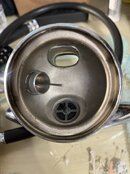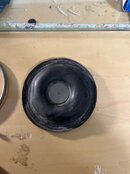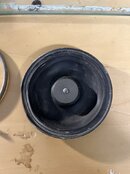SubSeaSports, the LP hose probably cannot be replaced, as the fittings on a tilt valve are different than today’s regulators.
Ghost95 and Robert H Diver,
The tilt valves were used extensively in the 1950s and early 1960s until U.S. Divers Company came out with its Calypso downstream valve. If you look, you have an ORV (overpressure relief valve) on this regulator, a Scuba Star regulator. It was my second regulator in the early 1960s. I dove it for several years, to a depth of somewhere around 45 feet in Hood Canal, Washington, and in Oregon lakes and rivers. It is an okay performer, but at depth it is a poor breather. There is no Venturi with this regulator, as the air is simply vented out the valve somewhat towards the mouthpiece. The ORV should be overhauled before diving it, and that is pretty easy to do. There is a thread on the vintagescuba.proboards.com website about overhauling the ORV.
I have a whole collection of Healthways single hose regulators, and have used their Scubair and Scuba Star in the Clackamas River.
You can improve your Scuba Star by removing one of the two exhaust valves (it‘s there to make it a dryer breathing regulator), and substituting a silicone mushroom valve for the neoprene ones that are in there now (Snorkel non-return valves of silicone work well; you can get these snorkels at Goodwill for next to nothing). The neoprene/nylon main second stage diaphragm can get hard. You can make it more flexible by coating it with silicone grease, letting it stand for a week, then picking it up and “exercising“ it by bending it back and forth. It is virtually unbreakable, with the nylon inside the neoprene. Or, Healthways made much better, more flexible second stage diaphragms, and your LDS may have some still around.
The mouthpiece is an older, neoprene one which may be hard, and could probably use being replaced by a modern one.
One other thing to look for is whether this regulator has a restrictor orifice within the first stage. This is a plate with a very small hole in the center. This was a means of creating a warning to the diver that you are running low on air, but making breathing harder as tank pressure drops below about 500 psig. You can “feel” the resistance and it will force you towards he surface to get back to easier breathing. This type of reserve, obviously, is not something to be used in overhead environments when you may be forced to go deeper to get out to the surface. You could buy this regulator either with a plate with a hole the size of the valve (no reserve) or a tiny hole (restrictor reserve) to be used with K-valve tanks.
Once these are accomplished, you may be surprised at the breathing characteristics. But, again this design is not for deep diving.
 Subtidal Clambed Survey004
Subtidal Clambed Survey004 by
John Ratliff, on Flickr
This is a research diver for. The Oregon Department of Fish and Wildlife using a Healthways single hose, two stage, tilt valve on subtidal clam bed surveys in 1975. He used this regulator in some very rigorous diving conditions. B
SeaRat







